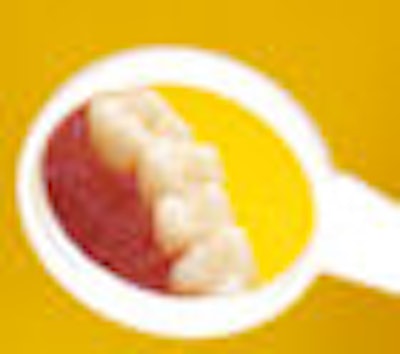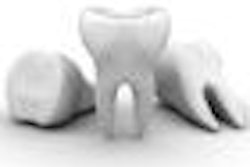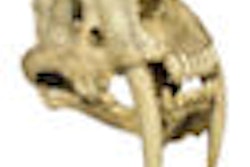
Researchers from Tufts University School of Dental Medicine have developed a new application for guided tissue regeneration that they say reduces the pain and recovery time of gum grafting surgery when compared to traditional methods.
Terrence Griffin, D.M.D., an associate professor and chair of the department of periodontology at Tufts, and colleagues conducted a three-year follow-up study that examined the stability of guided tissue regeneration as a treatment option for receding gums and found that complete root coverage had been maintained.
Their findings are published in the current issue of the Journal of Periodontology (July 2009, Vol. 80:7, pp. 1192-1199).
— Terrence Griffin, D.M.D., associate
professor and chair of the
department of periodontology,
Tufts University
Traditional gum grafting surgery requires surgically excising tissue from the palate to replace the gum tissue lost around the teeth. Previous research conducted by Dr. Griffin and his team has shown that all the postoperative bleeding and most of the postoperative pain were related to the gum tissue removed from the roof of the mouth for use as a graft (J Periodontol, December 2006, Vol. 77:12, pp. 2070-2079).
The tissue regeneration application developed at Tufts uses platelet concentrate gel applied to a collagen membrane as the graft instead of tissue from the roof of the mouth. The graft is soaked in the patient's platelets using blood drawn in the same visit, then sutured into place over the receding tooth root.
"Our previous research determined that pain and discomfort were barriers to receiving traditional gum grafting surgery," said co-author Wai Cheung, D.M.D., M.S., an assistant professor in the department of periodontology at Tufts (J Periodontol, December 2004, Vol. 75:12, pp. 1678-1687). "We have also shown previously that this treatment for gum recession results in proper coverage of the tooth root, better aesthetics than those found with traditional gum grafting surgery, and enhanced patient satisfaction with the results." In addition, the recovery time is typically faster because the platelet-rich plasma accelerates the healing process, Dr. Griffin added.
Three-year follow-up
Dr. Griffin and his colleagues have studied various alternatives to traditional gum grafting surgery since the early 1990s and have more than 20 publications on the topic. And they are not alone; a 2003 meta-analysis reviewed 40 investigations in which guided tissue regeneration was applied for root coverage and found that an average of 75% of exposed roots were covered, with complete coverage in 42% of the treated sites (J Periodontol, October 2003, Vol. 74:10, pp. 1520-1533).
Hoping to demonstrate the long-term stability of this approach, Dr. Griffin's group followed six patients between November 2004 and May 2008 who had a total of 37 Miller class I or II recession defects that were treated using platelet concentrate grafts and a collagen membrane covered by an advanced mucogingival flap. Previous research had suggested that by adding a bioabsorbable membrane, the space under the flap could be better maintained, thus improving the amount of root coverage, the researchers noted.
After the exposed root surfaces were scaled and planed using hand and electronic instruments, a low-dose tetracycline solution was applied to the root surface for each surgery -- not for antibiotic purposes but to enhance tissue attachment, the researchers noted. The recipient sites and platelet concentrate graft were prepared, and about 30 minutes prior to surgery, 54 mL of blood was drawn from each patient and the autogenous platelet concentrate collected. The concentrate was then soaked with a layer of collagen sponge and a collagen membrane.
Once the mucogingival flap was created, the graft was placed over the denuded roots and sutured into place. The flap was then positioned to completely cover the graft and it too was sutured into place. Following the procedure, patients were placed on chlorhexidine gluconate mouth rinse for four weeks and antibiotics for one week. Patients were also advised to follow routine periodontal mucogingival surgical post-op instructions.
Clinical parameters, such as vertical gingival recession depth, clinical attachment level, probing depth, and width of keratinized tissue were recorded prior to surgery and at six and 36 months post-op. At six months, 24 out of 37 teeth from the six patients had complete root coverage (65%), the researchers reported, while at 36 months, 21 out of 37 teeth from the six patients had complete root coverage (57%). The outcomes were stable over three years, with minimal recession and results comparable to traditional gum grafting surgery, they concluded.
"This treatment, while only marginally more expensive for the patient, is more time-consuming and technically more difficult for us," Dr. Griffin said. "It requires more expertise on the part of the surgeon because there is less margin for error. When using palatal tissue, the surgeon doesn't need to be as exacting. This approach is more technically complicated because the surgeon has to advance the flap and suture it precisely."
But the end result -- improved aesthetics, reduced pain, and, most important, improved oral health for the patient -- make it "a valuable and important alternative," he added. "Patients now have a less invasive treatment option for receding gums, and we now have evidence to support the stability of this relatively painless procedure."
Copyright © 2009 DrBicuspid.com



















